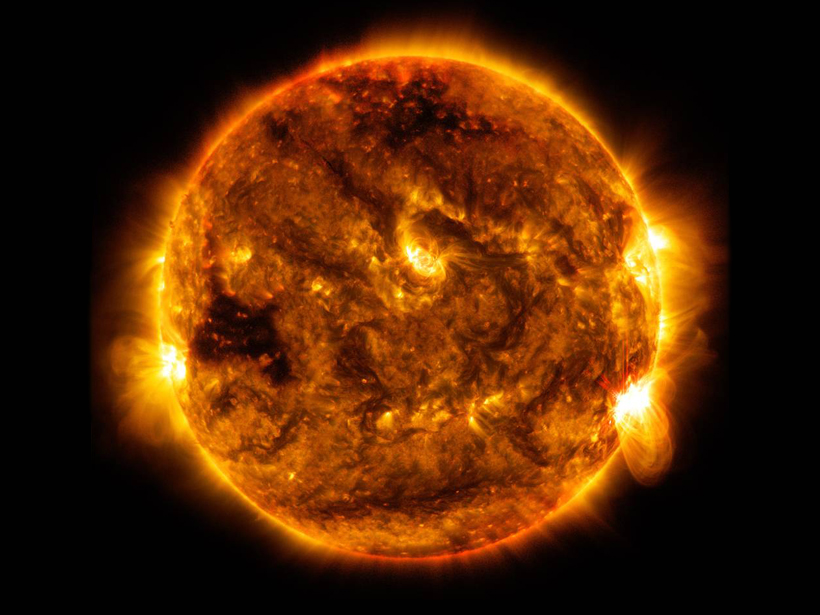Space weather is “a priority” for the Obama administration, according to White House science adviser John Holdren.
The White House is paying closer attention to the potential widespread damage that some powerful space weather storms emanating from the Sun can cause to electric power systems, satellite and aircraft operations, telecommunications, navigation, and other technology. On 29 October, the administration issued a new strategy and action plan to cope with space weather events.
Space weather is “a priority” for the Obama administration, White House science adviser John Holdren said at a 29 October White House forum to release the documents. “We absolutely need to ensure that our nation is appropriately prepared to respond to and recover from space weather events.”
Space weather events occur when outbursts from the Sun, such as solar flares, solar energetic particles, and coronal mass ejections, collide with Earth’s magnetic field. Although many of these events are harmless, some are powerful enough to cause havoc by disrupting critical technology. Speakers at the forum referred to a 1989 geomagnetic storm that cut electricity to 6 million Canadians for 9 hours and to the 1859 “Carrington” event, the largest documented series of geomagnetic storms from the Sun to have struck Earth.
Key Goals

The White House strategy calls for improving efforts to protect against and mitigate space weather risks; improving the fundamental understanding of space weather; and increasing the accuracy, reliability, and timeliness of space weather observations and forecasts. The action plan includes specific federal agency and interagency measures to implement the strategy.
A panel established a year ago—the interagency Space Weather Operations, Research and Mitigation (SWORM) task force—developed the strategy and action plan. This panel comprised representatives from 24 federal departments, agencies, and offices.
Bill Murtagh, assistant director for space weather at the White House Office of Science and Technology Policy, told Eos that a group is being formed to pick up where the SWORM task force left off to ensure implementation of the action plan. He noted that both sides of the aisle in Congress support taking action on space weather. “If it’s controversial at all, it’s ‘Are we doing enough?’” he said.
Vulnerability and Opportunity
During the late October forum, participants from government and industry agreed on the seriousness of the peril. “Although we have a lot to learn about the physics and phenomenology of space weather,” said National Oceanic and Atmospheric Administration (NOAA) Administrator Kathryn Sullivan, “there is no uncertainty” about society’s vulnerability to its storms.
William “Terry” Boston, chief executive officer emeritus of the largest power grid in North America, PJM Interconnection, agreed that geomagnetic disturbances pose “a clear and present threat to the [electrical] system.”
To the academic community, the action plan offers an opportunity “to contribute importantly to the national effort” through basic and operational research, said Louis Lanzerotti, a distinguished research professor of physics at the New Jersey Institute of Technology in Newark. The community is “going to be thrilled” with the action plan, he said at the forum.
Cooperative Effort
The new strategy “is long overdue,” and it partly makes up for “a very severe lack of regulation and appropriate standards for the U.S. electric grid,” Thomas Popik, chairman of the Foundation for Resilient Societies, told Eos. The foundation is a nonprofit concerned about the protection of North America’s electric grids and other critical infrastructure.
For Dan Baker, director of the Laboratory for Atmospheric and Space Physics at the University of Colorado Boulder, the cooperation between agencies inherent to the action plan suggests “we really have a chance for making this work.”
Baker hopes that the release of the space weather strategy and action plan “is a watershed moment where things are really going to change.”
There is “a golden opportunity” for collaboration between the academic, governmental, and commercial space weather sectors to improve forecasts and resilience to space weather events, agreed Conrad Lautenbacher, chief executive officer of the environmental data company GeoOptics and former NOAA administrator.
Baker, who chaired the National Research Council’s 2012 Decadal Survey for Solar and Space Physics, also expressed concern about continuity of implementation in future administrations and congressional support for the plan.
He told Eos that he hopes that the release of the space weather strategy and action plan “is a watershed moment where things are really going to change.”
—Randy Showstack, Staff Writer
Citation: Showstack, R. (2015), White House plan focuses on hazards from solar storms, Eos, 96, doi:10.1029/2015EO039015. Published on 6 November 2015.
Text © 2015. The authors. CC BY-NC 3.0
Except where otherwise noted, images are subject to copyright. Any reuse without express permission from the copyright owner is prohibited.

